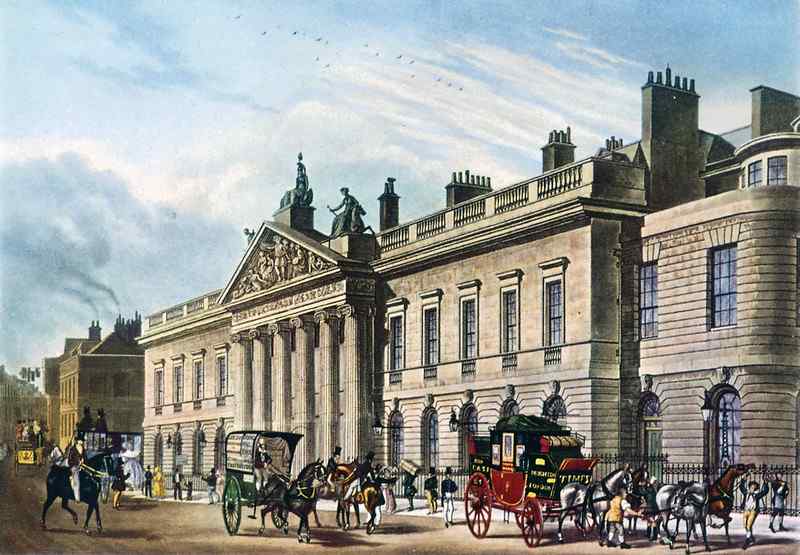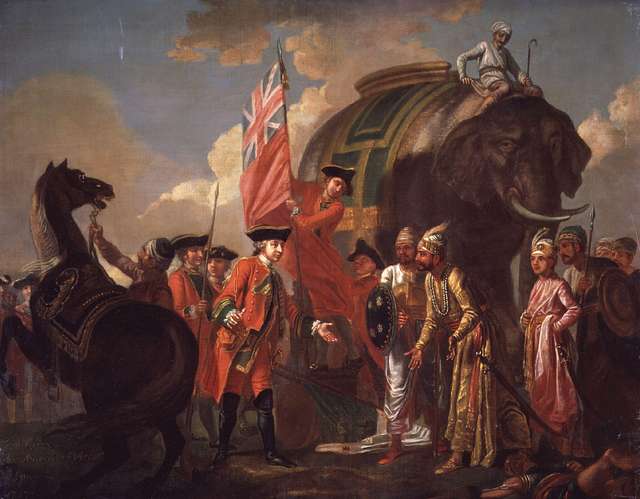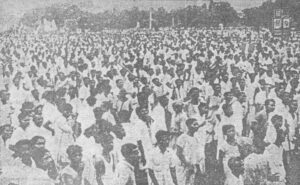East India Company, a small trading firm headquartered in London, governed much of India for a century. After the Battle of Plassey in 1757, company rule in India effectively began and lasted until 1858, when the British Crown took direct control of India following the Indian Rebellion of 1857. Is it true that the Company was first reluctant to acquire territories? So, how did they end up as rulers of such a massive empire?

Background Of East India Company
Looking into their background, the English joint-stock company was founded in 1600 to trade in the Indian Ocean region. Queen Elizabeth I granted the Company a charter allowing it exclusive rights to trade with the East. Their main business was to buy goods at low prices and carry them back to Europe to sell at higher prices.
In 1611, the Company opened its first factory in India, in Masulipatnam, on the Andhra Coast. The Company reported high profits after landing in India. In 1609, the King Of England renewed the East India Company’s charter for an indefinite period, with the provision that its privileges would be annulled if the trade was unprofitable for three consecutive years.
Conflict Between Company And Other European Traders
In England, the East India Company had a monopoly to trade with the East. The royal charter, on the other hand, did not prevent other European nations from penetrating the Eastern markets. The Portuguese were already present throughout the western coast of India. Soon the Dutch and French traders arrived on the scene.
Because all of Europe’s corporations wanted to buy the same products, there was a conflict. In Europe, good quality cotton and silk manufactured in India had a large market. The silk industry of Bengal developed with the European capital. Spices such as cinnamon, cardamom, cloves, and pepper were also in high demand.
Competition amongst the European companies pushed the purchasing prices of goods and reduced the profits of the companies. The only option for the trading corporations to thrive was to eliminate their rivals. Consequently, the desire to secure markets led to bitter rivalries between various trading organizations.
It was common for them to sink each other’s ships in the 17th and 18th centuries, preventing competing ships from transferring cargo. Trade was carried on with arms, and trading posts were fortified to protect them. This endeavor to defend towns and conduct successful trade also resulted in a lot of friction with local rulers. As a result, the Company found it impossible to separate business from politics.
Mughals And East India Company Realtions
Those days, Mughals controlled a large part of the country. The Company tried continuously to press for concessions from Mughal emperors.
During his visit to the Mughal Emperor Jahangir in 1612, an English envoy arranged for a commercial deal that would grant the Company exclusive rights to settle and develop factories in Surat and other locations. In return, the Company provided the Emperor with European products and rarities. The same year, the Company built a factory at Surat.
In 1634, the Mughal Emperor Shah Jahan welcomed English traders to Bengal. The first English factory was set up in Bengal on the banks of the river Hugli in 1651.
Anglo Mughal War
In 1682, the Company negotiated with the governor of the Bengal Subah, Shaista Khan, to obtain a firman that would allow them regular trading privileges across the Mughal provinces.
In 1685, the negotiations failed, and The Company refused the newly introduced taxes. The Company decided to get the province of Bengal to accept new terms in favor of its trading power. Upon request, the King of England sent warships to India.
The East India Company navy engaged the Mughal Army in battle and blockaded many Mughal ports on India’s western coast.
That was followed by orders from Emperor Aurangzeb to occupy and confiscate all East India Company assets throughout the subcontinent. Accordingly, only Madras and Bombay, fortified cities, remained under the East India Company.
In 1689 a Mughal fleet attacked Bombay. In 1690, the Company surrendered after a year of fighting, and envoys were sent to Aurangzeb’s camp to appeal for a pardon.
As punishment, the Company’s envoys had to prostrate themselves before the emperor, pay a heavy compensation, and vow to behave better in the future. The Company re-established itself in Bombay and created a new stronghold in Calcutta after the emperor withdrew his forces.
The Company bribed Mughal officials in 1698 to grant it zamindari powers over three villages. Kalikata was one of them. It eventually expanded into the city of Calcutta or present-day Kolkata.
Later, Mughal emperor Aurangzeb issued a Farman granting the Company the right to trade duty-free. But Company started manipulating these privileges. They refused to pay duty on private trade that caused an enormous loss of revenue for Bengal. It led to the conflict between the Company and the nawabs of Bengal.
Aurangzeb was the last powerful Mughal ruler. After he died in 1707, Delhi could no longer function as a controlling center.
East India Company Rule In Bengal
The strong rulers of Bengal, Murshid Quli Khan, followed by Alivardi Khan and then Sirajuddaulah, asserted their power and autonomy. They refused to provide concessions to the Company, demanded heavy tributes for their right to trade, denied it the right to print money, and prevented it from extending its fortifications, among other things.
They accused the Company of fraud, claiming that it was denying the Bengal government large sums of money and undermining the Nawab’s authority.
On its part, The Company declared that the unjust demands of the local officials were ruining the business of the Company, and the business could flourish only if the duties are removed. It was also convinced that to promote trade, it needed to expand settlements, purchase villages, and improve fortifications. The disagreements escalated into battles, culminating in the legendary Battle of Plassey.
The Battle of Plassey
In 1756, Sirajuddaulah succeeded Alivardi Khan as Nawab of Bengal. The Company was concerned about his power and desired a puppet ruler who would gladly grant trade concessions and other benefits. So it tried, though without success, to help one of Sirajuddaulah’s rivals become the Nawab.
Sirajdullah asked that the Company stop interfering in his dominion’s political issues, stop fortification and pay the revenues. He was furious with the Company.
Nawab marched with 30,000 soldiers to the English plant at Kassimbazar and seized the Company executives. He then locked up the warehouse and disarmed all Englishmen before blockading all of England’s shipping lanes and ships.
Then he proceeded to Calcutta to secure control over the Company’s fort there.
When word of Calcutta’s fall reached Madras, Company officials dispatched men led by Robert Clive and backed up by naval fleets.
In 1757, in Plassey, Robert Clive led the Company’s troops against Sirajuddaulah. The main reason for the Nawab’s defeat was that the forces led by Mir Jafar, the commander of the Bengal army, never fought by his side.
Clive had won his favor by offering to make him Nawab after Sirajuddaulah was defeated. Because it was the Company’s first important victory in India, the Battle of Plassey became historic.

Sirajuddaulah was slain after the defeat at Plassey, and Mir Jafar was appointed Nawab.
The Company was still unwilling to take over the territories. Its prime objective was the expansion of trade. They were able to achieve this with the help of local rulers who were willing to grant privileges. But, soon the Company discovered that this was rather difficult.
Even the puppet nawabs were not always willing to cooperate. After all, they had to maintain basic dignity and sovereignty to gain respect from their subjects. So, when Mir Jafar objected, the Company deposed him and replaced him with Mir Qasim. And, when Mir Qasim complained, Mir Jafar was reinstalled.
The Nawab was required to pay Rs 500,000 per month, but the Company needed more money to fund its battles, meet trade needs, and cover other costs. It wanted more territories as well as increased revenue.
By the time Mir Jafar died in 1765, the mood of the Company had changed. Having failed to work with puppet nawabs, The Company understood that they themselves have to become the Nawabs.
In 1765, Mughal emperor finally named the Company as Diwan of Bengal regions. The Diwani allowed the Company to collect the land revenue in Bengal. It meant that the Company acquired more power and authority. That’s not to mention the fact that it solved a critical problem that the Company had earlier faced.
Its trade with India had grown since the early eighteenth century. But it had to buy most of the stuff in India with gold and silver imported from Britain. It was because, at this time, Britain had no goods to sell in India. After the assumption of Diwani, the outflow of gold from Britain entirely stopped. Now revenues from India could finance Company expenses. As a result of this income, the Company was able to acquire cotton and silk fabrics in India, keep troops, and erect a fort and offices in Calcutta.
The Rising Of Colonial Power
When the English traders came into the country, they humbly petitioned the then government for liberty to purchase a spot of ground to build a factory house. But after the grant, they built a strong fort, surrounded it with a ditch which has communication with the river, and mounted a great number of guns upon the walls.
Following the Battle of Plassey, the nawabs of Bengal were forced to give land and large sums of money to Company officials as personal gifts.
Company officials amassed a fortune in India. Many of them came from humble backgrounds, and their main goal was to earn enough money in India so that they could return to Britain and live comfortably. Those who returned with wealth led flashy lives and flaunted their wealth.
The Company rarely launched a direct military attack on uncharted territory. Before annexing an Indian state, it expanded its power through political, economic, and diplomatic means.
The Company appointed political cum commercial agents, who began interfering in the internal affairs of Indian states. They tried to determine who would be the heir to the throne and who would be appointed to administrative positions.
Occasionally, the Company coerced the states into forming a subsidiary alliance. Indian kings were prohibited from having their own separate armed forces under the rules of this alliance.
If the Indian rulers did not pay on time, a portion of their territory was taken away as a penalty.
When the Company recognized a threat to its political or economic objectives, it resorted to direct armed confrontation. One such strong resistance it faced in the southern Indian state of Mysore.
Under powerful rulers like Haidar Ali and his famed son Tipu Sultan, Mysore had increased in strength. Mysore dominated the lucrative trade of the Malabar coast, from which the Company purchased pepper and cardamom.
Tipu Sultan banned the export of sandalwood, pepper, and cardamom via his kingdom’s ports in 1785. Tipu Sultan had a close relationship with the French in India and modernized his army with their help. The British were furious. Four wars were fought with Mysore. 1785. Only in the final battle, the Battle of Seringapatam did the Company triumph. Tipu Sultan was killed defending his capital Seringapatam.
It was not until the late eighteenth century that Maratha’s influence was curtailed and then eliminated. The Marathas were subdued in a series of Anglo-Maratha wars.
From the early nineteenth century, the Company pursued an aggressive policy of territorial expansion and had complete control over the territories south of the Vindhyas. From 1813, the British instituted a new policy of paramountcy. After that, the company maintained that its power was unchallenged and unquestioned. As a result, it wielded more power than Indian states.
It was justified in annexing or threatening to annex any Indian kingdom to protect its interests. This process, however, did not go unchallenged, and many states led an anti-British resistance movement. They did manage to destroy many British camps but were ultimately defeated.
Between 1838 and 1842, the East India Company fought a long war with Afghanistan, establishing indirect Company rule.
Sind was taken over in 1843. Next in line was Punjab. However, the presence of Maharaja Ranjit Singh hampered the Company. After he died in 1839, two prolonged wars were fought with the Sikh kingdom. Ultimately, in 1849, Punjab was annexed.
Lord Dalhousie, the Governor-General from 1848 to 1856, was responsible for the final wave of annexations. He devised a policy that came to be known as the Doctrine of Lapse. If an Indian King died without a male successor, the concept said that his kingdom would lapse and become part of the Company’s territory. Satara (1848), Sambalpur (1850), Udaipur (1852), Nagpur (1853), and Jhansi (1853) were all annexed using this doctrine.
Finally, in 1856, the Company acquired control of Awadh. The British had a new argument this time: they felt obligated by duty to take over Awadh and free the people from the Nawab’s misrule! The people of Awadh joined the great revolt that erupted in 1857, enraged by the humiliating manner in which the Nawab was ousted.
About 63 percent of the territory and 78 percent of the inhabitants of the Indian subcontinent were directly under the Company’s control by the year 1857. As a result of the East India Company’s direct and indirect influence on India’s remaining territory and population, it effectively controlled the whole country.
Thus the East India Company had transformed from a trading company to territorial colonial power.
During the mid-1700s and early 1800s, the Company accounted for half of the world’s trade, particularly in commodities such as silk, cotton, indigo dye, salt, sugar, spices, tea, saltpetre, and opium.
End Of Company Rule
As the English East India Company entered its 100th year of conquest and administration, it faced a tremendous revolt that began in May 1857. It threatened the Company’s very presence in India. Sepoys mutinied in several locations, and a large number of people from all walks of life rose in revolt.
The Company, alarmed by the size of the upheaval, determined to crush the rebellion with all its strength. It brought reinforcements from England, passed new laws to convict the rebels with ease.
Only by the end of 1859 British were able to regain control of the country. It was clear, however, that the Company could not continue to rule the land with the same policies anymore.
To ensure more responsible management of Indian affairs, the British Parliament passed a new Act in 1858 transferring the East India Company’s obligations to the British Crown.
Despite continuous government involvement, the Company’s finances were always in trouble. The Company was dissolved in 1874.










